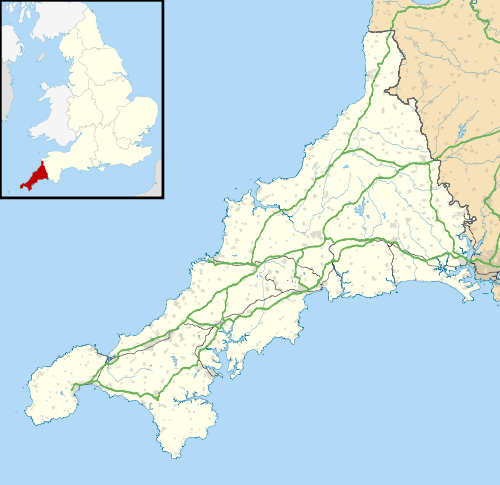St Ive
Coordinates: 50°28′48″N 4°22′55″W / 50.480°N 4.382°W
St Ive (/ˈiːv/ EEV; Cornish: Sen Iv) is a village and civil parish in eastern Cornwall, England, United Kingdom. The village is split into four parts: St Ive Church End, St Ive Cross, St Ive Keason and St Ive Parkfield. In addition to the Parish an electoral ward exists stretching north of St Ive. The population at the 2011 census was 4,246.[1]
History and geography

The parish used to be a large rural area of rolling landscape with wooded valleys and the population was sparse with the largest village being St Ive itself, sited on the A390. The hamlet of Woolston lies to the northwest of St Ive. The demography of the parish was radically altered with the mid-Victorian mining boom centred on Caradon Hill. South Caradon Mine situated just over the parish border was at one time the largest and most prosperous copper mine in the world.
Leonard Trelawny Hobhouse, politician and sociologist, and his sister Emily Hobhouse, the social activist, were both born in St Ive.
Parish church
The parish church is probably dedicated to Saint Ive. However it is not certain whether he was a supposedly Persian bishop whose body was found in 1001 at St Ives in Cambridgeshire.[2] The building is mainly 14th century and similar to the church of South Hill, though more elaborate in detail. The consecration of the church in 1338 is recorded in the diocesan register. The south aisle, south porch and the top of the tower were added either in the 15th or early 16th century: (the tower has 12 pinnacles). The pulpit is dated 1700 but is in the Jacobean style. A monument to J. Lyne, d. 1791, is by Robert Isbell; another monument to a member of the Wrey family, formerly of Trebeigh Manor within the parish, was moved to their principal seat of Tawstock, Devon, in 1924.[3]
Trebeigh Manor
Trebeigh, St Ive, in Cornwall was a manor listed in Domesday Book as held by the Earl of Mortain, the largest landholder in that county. He is said to have taken it away wrongfully from the church. Contrary to popular belief, it was never owned by the Knights Templar.[4] In 1338 Trebeigh belonged to the Hospital of St John or Knights Hospitaller, later the Knights of Malta, and formed the Preceptory of Trebeigh.[5] Following the Dissolution of the Monasteries the manor of Trebeigh was granted by Queen Elizabeth I in 1573 to Henry Wilbye and George Blyke, from whom it was acquired by John Wrey,[6] who made it his family's chief seat until his descendants inherited Tawstock in Devon from the Bourchiers in 1654.[7] The family owned the Wheal Wrey mine in the parish.
Notable residents
- Emily Hobhouse, (9 April 1860 – 8 June 1926), Welfare campaigner, who is primarily remembered for bringing to the attention of the British public, and working to change, the appalling conditions inside the British concentration camps in South Africa built for Boer women and children during the Second Boer War. She was also the author of the Open Christmas Letter during the First World War. Hobhouse's ashes were ensconced at the foot of the National Women's Monument.
References
- ↑ "Ward population 2011.Retrieved 13 Feb 2015".
- ↑ Orme, Nicholas (2000). The Saints of Cornwall. Oxford: Oxford University Press. pp. 148–149. ISBN 0-19-820765-4.
- ↑ Pevsner, N. (1970) Cornwall; 2nd ed. Penguin Books; p. 179
- ↑ Trebeigh and St Ive are not mentioned in the Templars' Inquest of 1185 (published by Beatrice A. Lees, ed., Records of the Templars in England in the Twelfth Century: The Inquest of 1185 with Illustrative Charters and Documents (London: Oxford University Press, 1935): the Cornish properties are on p. 60); nor are they mentioned in the accounts produced by King Edward II's officials for the Templars' properties in Cornwall after the Templars' arrest in 1308 (Kew, The National Archives of the UK: E 358/20 rot. 11).
- ↑ A document of 1338 in the National Library of Malta (Archives of Malta, AOM 2191) lists the preceptory among the Hospitallers' own estates and states that two Hospitallers were living there. It records that the Hospitallers of St Ive had a dwelling house with a garden, dovecote and watermill and gives prices of food and grain: Lambert B. Larking, ed. (with introduction by John Mitchell Kemble), The Knights Hospitallers in England: Being the Report of Prior Philip de Thame to the Grand Master Elyan de Villanova for A.D. 1338, Camden Society 1st series 65 (London: Camden Society, 1857), pp. 15–16.
- ↑ "Descent of Trebeigh per Listed Buildings text".
- ↑ Vivian, (ed.), Heralds' Visitations of Devon, 1895, p.107
External links
| Wikimedia Commons has media related to St Ive. |
